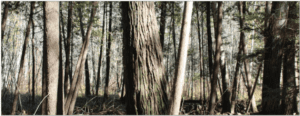By Gary Salmon
Several years ago, Michael Wojtech’s book, “BARK: A Field Guide to Trees of the Northeast,” came out, which helped in this difficult identification process. Bark is not as consistent as leaves are and changes as the tree gets older, as rates of growth change over time, and where on the tree the bark is observed (lower trunk or upper crown).

Trees in West Rutland cast shadows on the forest floor after the leaves have fallen for winter.
After the leaves have fallen, two different tree species come up for discussion: One is a collection of several trees on the Mitchell Road in Shrewsbury and the other is a very large tree along the West Rutland boardwalk trail. Any forester or arborist who has spent time amongst trees can identify most of the common trees of Vermont and perhaps New England by bark. It becomes a part of you until you encounter one that is just not right. The Mitchell Road trees all exceed 12” with beautifully formed straight stems and full crowns. They look like ash but they are not. After comparing the bark with several other species, the conclusion is that they might be a hickory. Hickories are certainly a rare tree to be found in the northern hardwood forests of Shrewsbury or Killington and how these got there is anyone’s guess, although being found along a town road suggests having been planted.
The other mystery tree in West Rutland is mixed in with some very large white pine and hemlock but more than holds its own in size at over 3 feet in diameter. Its location, as a part of this undisturbed forest, suggests that it is part of this natural setting rather than having been a planted addition to it. A look at the lower bark makes it appear to be a red oak but the upper crown is a silvery white that looks like an aspen. It can’t be both. Based on tree size, this would be a new state record “big tree” for either one.




